|
How
the Public Views the Media
The
People & The Press, 1997 •
What the People Want
from the Press •
ASNE Journalism Credibility Project, 1998 •
The People & The Press,
2000 •
The Gallup Organization •
The People & The Press, 2003 •
Bias
in the 2004 Presidential Campaign •
Missouri School of Journalism,
2004 •
American Journalism Review, 2005 •
CBS’s "State of the
Media," 2006 •
Zogby Survey, 2007 •
Coverage of the War in
Iraq, 2007
 Oct.
2008: By Nearly 8-to-1, Voters Say Journalists Want Obama to Win
Oct.
2008: By Nearly 8-to-1, Voters Say Journalists Want Obama to Win
 Sept. 2008: By 5-to-1 Public Thinks Most Journalists Trying to Elect
Obama
Sept. 2008: By 5-to-1 Public Thinks Most Journalists Trying to Elect
Obama
Sept. 2008: Rasmussen: By 10-to-1 Public Says Reporters 'Trying to
Hurt Palin'
August 2008: Pew Finds Media Credibility Plummets to All-Time Lows
August 2008. Rasmussen: '55% Say Media Bias Bigger Problem than
Campaign Cash'
July 2008. Fox News: Two-Thirds Recognize Journalists Want Obama to
Win\
July 2008. Rasmussen: Many More See Pro-Obama Than Pro-McCain Bias
June 2008. Pew: Many Recognize Media's Pro-Obama Bias, Democrats
Prefer CNN
Feb. 2008. Rasmussen: Only 24% Have Favorable View of NY Times, 44%
Unfavorable
Jan. 2008. Sacred Heart University: Americans Slam News Media on
Believability
Nov. 2007. Harvard's JFK School: Twice as Many See Media as Too
Liberal as Too Conservative
July 2007. Rasmussen Poll: By 2-to-1, Nets Biased to Left; FNC Less
Biased
August 2007. Pew: Most See Media as Liberal, More Trust Military
than Media on Iraq
The People & The
Press, 1997
One of the most comprehensive surveys of the public’s general
opinion of the media was done in 1997 by the
Pew Research Center for
The People & The Press, formerly known as the Times Mirror Center
for the People and the Press. This research compared poll results
from the mid-1980s with the late-1990s, (using identical questions)
and determined a growing percentage of the public realize the media
are biased.
KEY FINDINGS:
- Two-thirds (67%)
said agreed with the statement: “In dealing with political and
social issues, news organizations tend to favor one side.” That
was up 14 points from 53 percent who gave that answer in 1985.
- Those who believed
the media “deal fairly with all sides” fell from 34 percent to 27
percent.
- “In one of the most
telling complaints, a majority (54%) of Americans believe the news
media gets in the way of society solving its problems,” Pew
reported.
- Republicans “are
more likely to say news organizations favor one side than are
Democrats or independents (77 percent vs. 58 percent and 69
percent, respectively).”
- The percentage who
felt “news organizations get the facts straight” fell from 55
percent to 37 percent.
What the People
Want from the Press
In November 1996, the
Center for Media and Public Affairs (CMPA) partnered with the Lou
Harris Organization to poll 3,000 people about their attitudes
toward the press. According to the poll, those who saw a liberal
bias outnumbered those who perceived a conservative bias by
two-to-one. The results of the poll were published in the May/June
1997 Media Monitor, the CMPA’s newsletter and later released as a
226-page report, What the People Want from the Press.
KEY FINDINGS:
- CMPA reported:
“Majorities of all major groups in the population, including 70
percent of self-described liberals, now see a ‘fair amount’ or
‘great deal’ of bias in the news. In general, perceptions of bias
rise along with levels of education and political participation.”
- “Those who see a
liberal tilt outnumber those who detect a conservative bias by
more than a two to one margin. Forty-three percent describe the
news media’s perspective on politics as liberal, compared to 33
percent who see it as a middle of the road, and 19 percent who
find it to be conservative.”
- “Even
self-described liberals agree: 41 percent see the media as
liberal, compared to only 22 percent who find the news to be
conservative.”
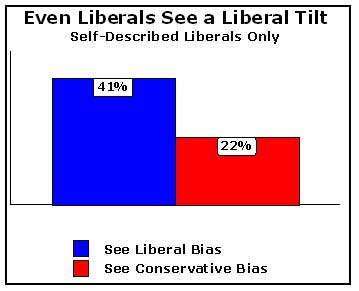
- “These findings
challenge the argument of some journalists that bias is purely in
the eye of the beholder. Although conservatives are three times
more likely to see liberal rather than conservative bias,
moderates and liberals alike see liberal bias in the media twice
as often as they see conservative bias,” CMPA concluded.
ASNE Journalism
Credibility Project, 1998
As part of “a $1
million project to improve the credibility of newspapers and
journalism,” the American Society of Newspaper Editors commissioned
a poll of 3,000 Americans in April and May of 1998. The survey found
that more than three-fourths of Americans (78%) believed that the
press is biased, and an equal percentage believed that reporters
would “spike or spin” a story to suit powerful interests. The
findings were detailed in a 1999 report,
Examining Our Credibility:
Perspectives of the Public and the Press.
KEY FINDINGS:
- “78 percent of U.S.
adults agree with the assessment that there is bias in the news
media,” the report found.
- “58 percent believe
that the public’s dissatisfaction with the media is justified — as
opposed to 29 percent who say the press is ‘an easy target for
deeper problems in our society.’”
- “78 percent believe
that powerful people can get stories into the paper — or keep them
out.”
- “50 percent believe
there are particular people or groups that get a ‘special break’
in news coverage, and 45 percent believe that others ‘don’t get a
fair shake.’”
- “77 percent believe
newspapers pay lots more attention to stories that support their
own point of view.”
- “Although a
sizeable portion of the public (46 percent) thinks that their
newspaper is more liberal than they, another significant segment
(36 percent) see the newspaper as more conservative than
themselves,” ASNE found.
The People & The
Press, 2000
During the election
year, the Pew Research Center for The People & The Press frequently polled public attitudes about the media. In an
October 15, 2000
report, the group found that most voters “generally believe the
media has been fair to both major presidential candidates, but more
say the press has been fair to Al Gore than to George W. Bush.” In
fact, the vast majority of respondents (89%) agreed that reporters’
political views often or sometimes influenced the coverage.
KEY FINDINGS:
- When asked, “How
often do you think members of the news media let their own
political preferences influence the way they report the news?” 57
percent said “often,” and another 32 percent said “sometimes.”
Just 8 percent said “seldom,” and only one percent thought
reporters’ preferences “never” influenced their coverage.
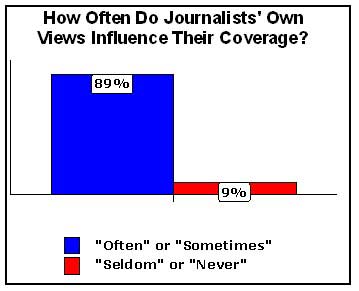
- Nearly half of the
public (47%) thought reporters wanted to see Democratic candidate
Al Gore win the 2000 election; just 23 percent thought reporters
were hoping for a victory by Republican George W. Bush.
The Gallup
Organization
Since 2001, Gallup has polled
American adults on the question: Now thinking for a moment about the
news media: In general, do you think the news media is [sic] too
liberal, just about right, or too conservative.
For
six consecutive years, the number of Americans saying the media
are too liberal has outnumbered those seeing a pro-conservative bias
by about a three-to-one margin. Gallup also found that while a large
majority of Democrats said they had trust and confidence in the
media, a similarly large percentage of Republicans expressed little
or no trust in the media.
KEY FINDINGS:
- In September 2006, more
than twice as many Americans said that the media are too liberal
(44%) than said the media are too conservative (19%).
- Since 2001, the percentage
saying the media are too liberal has ranged from 44 percent to 48
percent; the percentage seeing the media as too conservative has
never exceeded 19 percent.
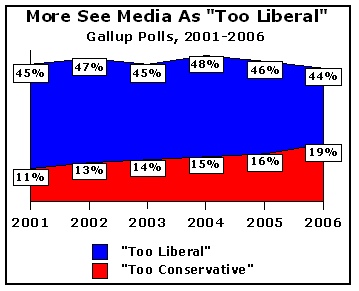
- In 2005, only 3 in 10
Republicans (31%) told Gallup they had a great deal or fair amount
of trust and confidence in the media, while the vast majority of
Republicans (69%) said they had very little or no trust in the
media. Democrats were much more trusting, with 70% expressing a
great deal or fair amount confidence in the media and 30%
reporting very little or no confidence.
The People & The
Press, 2003
In the summer of 2003,
Princeton Survey Research Associates conducted a poll of 1,201
American adults regarding the media for the
Pew Research Center for
The People & The Press. They found that a majority (53%) of
Americans regard the press as “politically biased,” and most said
the media tilted to the left.
KEY FINDINGS:
- “Most Americans
(53%) believe that news organizations are politically biased,
while just 29 percent say they are careful to remove bias from
their reports,” Pew reported.
- “When it comes to
describing the press, twice as many say news organizations are
“liberal” (51%) than “conservative” (26%) while 14 percent say
neither phrase applies.”
- Even Democrats
thought the press tilted left, not right. Among Democratic
respondents, 41 percent thought the media are liberal, compared to
33 percent who found the media to be conservative. Among
Republicans, 65 percent said the press is liberal, 22 percent find
the media to be conservative.
- “Americans are
divided over whether press criticism of the military serves to
keep the nation militarily prepared (45%) or to weaken the
country’s defenses (43%),” Pew found. Republicans were
especially likely (63%) to say that media criticism was harmful to
national defense.
Bias in the 2004
Presidential Campaign
Four different polls
conducted in the last days and immediate aftermath of the 2004
presidential campaign found the public more inclined to see the
media as biased in favor of Democratic candidate John Kerry than
Republican George W. Bush. Polls by the Pew Research Center and
Gallup in the final weeks of the campaign found twice as many
thought the media had been biased in favor of Kerry than saw a
pro-Bush tilt. An Election Day survey of voters in 12 battleground
states also found one out of every three voters (32%) thought news
coverage was biased in favor of Kerry and the Democrats, compared to
just 14 percent who thought the media were slanted in favor of Bush
and the Republicans. And a Pew Research Center poll conducted after
the election found that 40 percent of voters believed that media
coverage of President Bush had been unfair, compared to 31 percent
who thought Senator Kerry’s coverage was unfair.
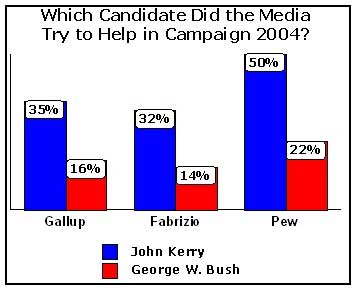
KEY FINDINGS:
- A Gallup poll of
1,538 registered voters conducted October 22-24, 2004 found a
plurality (45%) thought the media coverage has not been biased
toward either candidate. But of the remainder, most (35%) said the
coverage had been biased in Kerry’s favor, while fewer than half
that number (16%) thought coverage had been biased in favor of
Bush.
- The
Pew Research
Center surveyed 1,307 registered voters between October 15-19,
2004. “Half of voters (50%) say most newspaper and TV reporters
would prefer to see John Kerry win the election, compared with
just 22% who think that most journalists are pulling for George
Bush,” Pew reported.
- That pre-election
poll also found that a large majority of voters thought the news
media had too much clout: “Nearly six-in-ten (62%) say news
organizations have too much influence in determining the
election’s outcome; only about half that number (32%) feel that
the media's influence is appropriate.”
- A poll of 1,000
voters conducted on Election Day by
Fabrizio, McLaughlin &
Associates of voters in 12 closely-fought “battleground” states
found that more voters felt the news media’s campaign coverage had
been biased (46%) than thought the media coverage had not been
skewed (42%). Of those who saw bias, more than twice as many (32%)
said the news media had favored John Kerry as felt the media had
favored George W. Bush (14%).
- A post-election
survey of 1,209 voters conducted by the Pew Research Center
(November 5-8, 2004) reported that “voters are increasingly
troubled by what they see as the media’s unfair treatment of the
candidates. While a majority (56%) view press coverage of Bush's
campaign as fair, four-in-ten [40%] think it was unfair, up from
30 percent four years ago.”
- The
Pew report
continued: “Significantly more voters (65%) believe the press was
fair in its coverage of the Kerry campaign. However, a growing
minority also views this coverage as unfair — 31 percent say that
now, compared with 24 percent who faulted press coverage of Al
Gore's campaign four years ago.”
Missouri School of
Journalism, 2004
The Missouri School of
Journalism’s Center for Advanced Social Research surveyed 495 adults
about their attitudes toward the press during June and July of 2004.
Their results, released in April 2005, showed that most Americans
(85%) thought that news reporting was biased, although a smaller
majority (62%) still said they considered journalism credible. Of
those who thought the media were biased, most said the bias favored
liberals.
KEY FINDINGS:
- Nearly six out of
seven adults (85%) said there was a bias in news reporting. “Of
those, 48 percent identified it as liberal, 30 percent as
conservative, 12 percent as both, and 3 percent as other bias,” an
April 27, 2005 Associated Press report summarized.
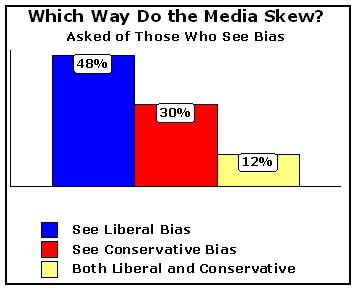
- According to the AP
summary, “74 percent said reporters tend to favor one side over
the other when covering political and social issues.”
- “58 percent said
journalists have too much influence over what happens in the
world.”
- “77 percent said
they think a news story is sometimes killed or buried if it is
embarrassing or damaging to the financial interests of a news
organization.”
American Journalism
Review, 2005
In May 2005, Gannett's
First Amendment Center in Nashville polled Americans about their
attitudes towards the media. Some exclusive results were published
in the
August/September 2005 edition of the American Journalism
Review. The article by senior writer Rachel Smolkin revealed that
nearly two-thirds (64%) reject the notion that “the news media try
to report the news without bias,” and nearly the same number (65%)
agreed that “the falsifying or making up of stories in the American
news media is a widespread problem.”
KEY FINDINGS:
- When read the
statement, “Overall, the news media tries to report the news
without bias,” 64 percent disagreed (42% saying they disagreed
strongly, 22 percent saying they mildly disagreed.) Only 13
percent strongly agreed that the media attempt to keep bias out of
the news.
- When told “The
falsifying or making up of stories in the American news media is a
widespread problem,” 40 percent strongly agreed and an additional
25 percent mildly agreed. Just 11 percent strongly disagreed.
CBS’s "State of the Media,"
2006
In late January 2006, a
CBS News/New York Times
poll asked 1,229 adults about their attitudes toward the news media
as part of a "State of the Media" segment on the CBS Evening News.
The poll found the public’s view of the media divided by
partisanship, with self-identified Democrats most confident of the
media’s ability to report news "fully, accurately and fairly" and
"tell the truth" all or most of the time, and Republicans expressing
much more skepticism.
KEY FINDINGS:
- The poll discovered "large majorities of Democrats and
liberals (about seven in 10 of each) think the news media tell the
truth all or most of the time. About half of Republicans and
conservatives agree."
- Four out of every ten respondents (including 47% of
self-identified Republicans) said they thought the news media tell
the truth "only some of the time or hardly ever."
- Just over a third of adults (36%) said they had "not very
much" confidence or "none at all" in the news media’s ability to
report the news "fully, accurately and fairly." Nearly half of
Republicans (48%) expressed little confidence in the news media,
while three-fourths of Democrats (75%) said they had "a great
deal" or "a fair amount" of confidence in the media.
- More than a third of respondents (35%) said the media have
been "harder on George W. Bush" compared to other presidents,
compared to just 18 percent who said the media have been "easier
on George W. Bush."
- Three out of five Republicans (61%) said they thought the news
media had been harder on Bush than previous presidents. A third of
independents (36%) and one out of ten Democrats (11%) agreed.
- Virtually no Republicans thought media coverage of Bush has
been easier than past presidents, but 16 percent of independents
and 34 percent of Democrats said coverage of Bush has been softer.
Institute for Politics,
Democracy and the Internet/Zogby Survey, 2007
In a February 20-26, 2007 survey conducted for the Politics
Online Conference 2007, the George Washington University's Institute
for Politics, Democracy and the Internet paired with
Zogby
Interactive to question 1,757 likely voters about their perceptions
of media bias. The pollsters found "the vast majority of American
voters believe media bias is alive and well," with only a tiny 11
percent of the public saying they don't think the media take
political sides. And by a huge margin, the public suggested the
media's bias tilts in favor of liberals, not conservatives.
KEY FINDINGS:
The vast majority of American voters detected media bias: "83
percent of likely voters said the media is biased in one direction
or another, while just 11 percent believe the media doesn't take
political sides," Zogby reported.
By a huge margin, most of those who saw media bias thought it
favored liberals: "Nearly two-thirds of those online respondents
who detected bias in the media (64 percent) said the media leans
left, while slightly more than a quarter of respondents (28
percent) said they see a conservative bias."
Republicans and independents both saw the media as dominated
by liberals, and even some Democratic voters agreed: "While 97
percent of Republicans surveyed said the media are liberal,
two-thirds of political independents feel the same....Just
two-thirds of Democrats were certain the media skewed right — and
17 percent said the bias favored the left."
Coverage of the War in Iraq, 2007
Two polls conducted in early 2007 found the public generally
thought the media's coverage of the war in Iraq skewed in a
negative, pessimistic direction. A March 5-11 TIPP poll of 900
adults done for Investor's Business Daily found the public judged
the media's war coverage as "neither fair nor objective." A Pew
Research Center analysis published April 5 found a huge drop from
2003 to 2007 in the percentage of Americans who said they were
"confident" that they were getting an accurate picture of how the
war was going, with Republicans much more trusting of statements
from official military sources, and Democrats preferring the media's
message.
KEY FINDINGS:
When
TIPP/IBD asked whether "generally speaking, [has]
coverage of the war been fair and objective," only 35 percent
agreed, compared to 62 percent who disagreed.
The TIPP/IBD poll also found that most Americans thought media
coverage of the war in Iraq was too negative (57 percent) and too
liberal in viewpoint (55 percent).
The
Pew Research Center analysis found that while 81
percent of the overall public voiced confidence in the accuracy of
media reports when the war began in March 2003, that had dropped
to just 38 percent in March 2007.
Pew discovered a sharp partisan divide: "The vast majority of
Republicans (73 percent) remain at least somewhat confident in the
military's portrayal of how the war is going, compared with just
32 percent of Democrats."
When it came to trusting the media, "fewer than a third of
Republicans (29 percent) feel confident in what they are hearing
from the press, while about half of Democrats (51 percent) remain
confident in the news from Iraq."
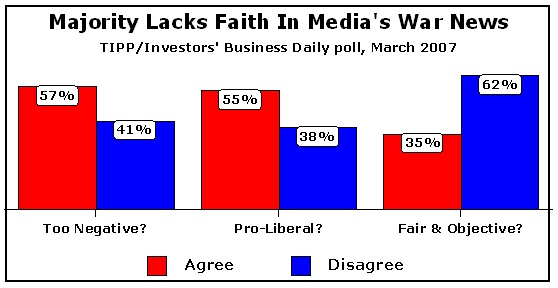
Media Bias Basics Home
• How the Media Vote
• Journalists' Political Views
• How the Public Views the Media •
Admissions of Liberal Bias •
Denials of Liberal Bias
 Print-Friendly
Version
Print-Friendly
Version |